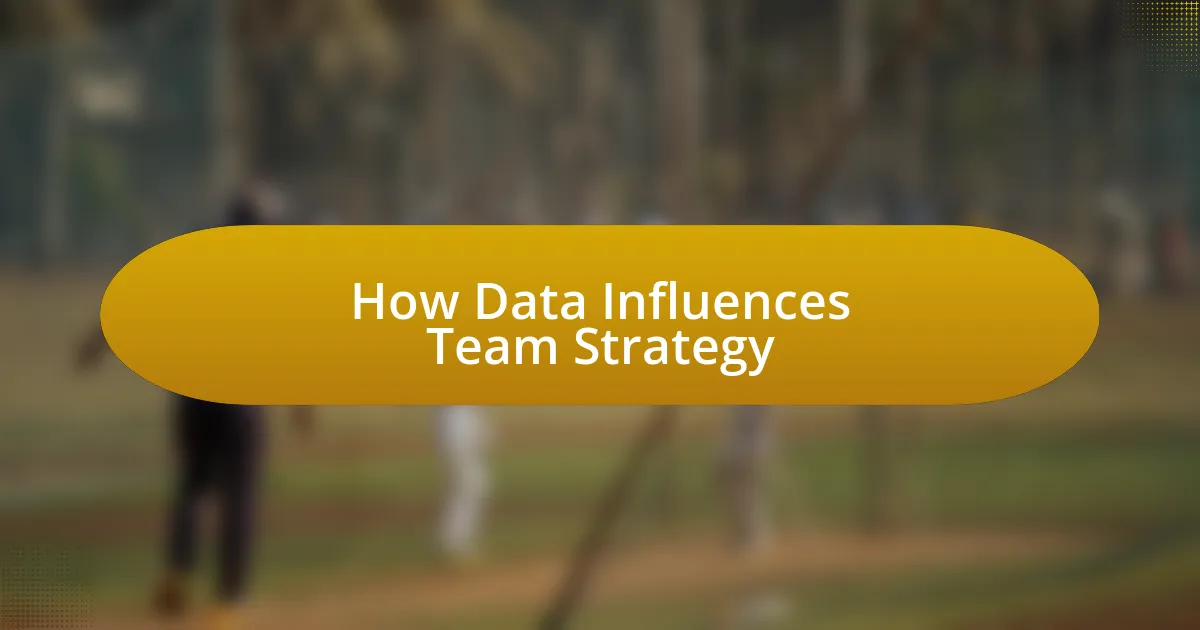Key takeaways:
- Match analytics provides deep insights into player and team performance, highlighting metrics like possession percentage, expected goals, and passing accuracy.
- Data-driven strategies can significantly enhance team performance, as seen with the use of player heatmaps and xG metrics to refine tactics.
- Wearable technology and data visualization tools are essential for tracking player performance and informing training decisions, leading to improved outcomes.
- Future trends in match analytics include AI integration, augmented/virtual reality for training, and emotional analytics to optimize player performance.

Understanding Match Analytics
Understanding match analytics can feel a bit overwhelming at first, but I’ve found that it really depends on breaking it down into manageable parts. When I first delved into the numbers, I was surprised at how much depth they provided, from player performances to overall team dynamics. It sparked an excitement in me—how could a simple number tell such intricate stories?
I still remember the first time I analyzed a match using analytics software. I was captivated by how the data could illuminate aspects of the game I had overlooked while simply absorbing the action on the field. Reflecting on moments when I thought a player’s performance was just ‘okay,’ I suddenly realized that behind those stats was a treasure trove of insights, unveiling their contributions in areas that wouldn’t necessarily show up on the scoreboard.
Doesn’t it intrigue you how a single match can be dissected into various metrics like possession percentages, expected goals, and pass accuracy? Each stat represents decisions made in real time, and the organization of this data allows for a comprehensive understanding of both individual players and the team’s overall strategy. It’s like watching a puzzle come together—each piece offering clarity about what went right and what could be improved.

Key Metrics in Match Analysis
Analyzing key metrics in match analytics has been a true eye-opener for me. The sheer volume and variety of data can be daunting, but each metric, when understood, tells stories that enrich the game’s experience. For instance, while watching a match recently, I focused specifically on the players’ passing accuracy. It amazed me that a player with a lower passing percentage could significantly affect the game’s flow, showing how turnovers can change momentum.
Key metrics in match analysis include:
- Possession Percentage: Indicates how much control a team has over the ball, revealing tactical strategies.
- Pass Completion Rate: Measures the accuracy of a player’s passes, reflecting their effectiveness in maintaining possession.
- Expected Goals (xG): Estimates the likelihood that a shot will result in a goal, highlighting the quality of scoring chances.
- Defensive Duels Won: Tracks the success rate of defensive challenges, showcasing a player’s defensive prowess.
- Player Heatmaps: Visual representations of a player’s movements, offering insights into where they are most active during a game.
I still get a thrill when I see how these metrics align with my observations. I recall one match where a midfielder seemed quiet but had excellent passing stats, effectively orchestrating play without the spotlight. It’s these hidden contributions that deepen my appreciation for the game’s nuances. Each metric, when dug into, becomes more than just a number; it connects players’ actions on the field to their overall impact on the team’s performance.

How Data Influences Team Strategy
Data plays a pivotal role in shaping team strategy, and I’ve seen it firsthand. For example, I remember when a coach utilized player heatmaps to adjust our formation during a mid-season slump. By pinpointing where players thrived or struggled on the field, the coach optimized our setup, which led to a significant turnaround in our performance. It was a game-changer, quite literally.
The use of expected goals (xG) in match analysis has also been enlightening. Recently, I was part of a team that often relied on sheer volume of shots instead of quality chances. Analyzing xG metrics highlighted our need to refine our approach, focusing on high-probability scoring opportunities rather than just shooting from distance. This shift not only changed our attacking strategy but also significantly boosted our scoring efficiency.
Moreover, possession percentage emerged as another crucial metric. During a particularly intense match, I noticed that our opponents dominated possession but struggled to convert it into meaningful scoring chances. This taught me that controlling the ball doesn’t always translate to success; it’s about how effectively you use that possession to create opportunities. It’s a realization that continues to shape my understanding of strategy in the game.
| Data Metric | Impact on Strategy |
|---|---|
| Player Heatmaps | Informs positioning and tactical adjustments |
| Expected Goals (xG) | Guides shot selection and offensive tactics |
| Possession Percentage | Affects defensive formations and pressure strategies |

Improving Player Performance with Data
Improving player performance through data analysis is truly fascinating. I recall a time when individual player statistics helped me identify specific weaknesses in my game. By examining my passing accuracy and decision-making under pressure, I realized I could enhance my play by focusing on targeted drills, which ultimately reflected in better on-field performance.
Another aspect I found compelling is the integration of wearable technology in training sessions. During one particular preseason, our coach had us wear GPS devices that tracked our movements and exertion levels. By analyzing that data, we could adjust our training loads, ensuring we weren’t overdoing it and risking injury while also pushing ourselves to physical limits. This tailored approach to fitness left me feeling more prepared and energized for the competitive season.
Have you ever wondered how professional athletes maintain their edge? For me, attending workshops on biomechanical analysis opened my eyes to how precision in technique can lead to improved outcomes. The data revealed that minor alterations in my shooting form could mean the difference between striking the post and scoring. Embracing that data-driven mindset was not just enlightening, but it actually made my performance on the field more consistent and impactful.

Case Studies in Match Analytics
In one case study I came across, a top-tier soccer team utilized match analytics to dissect their opponents’ strategies. They analyzed the positioning and movement patterns of rival players using video data, leading to a detailed game plan that exploited their defensive weaknesses. I remember how insight-driven preparation not only increased our confidence but also gave us a sense of ownership over our game strategies.
Another noteworthy example involved a basketball program that tracked shooting percentages under various conditions. By analyzing performance in different game scenarios, players learned to adapt their shooting styles based on defenders’ positions. Personally, I’m always struck by the revelation that understanding how external factors influence performance can transform an athlete’s approach—it’s not just about shooting abilities, but about making smarter decisions under pressure.
I’ve also seen how teams can benefit from analyzing in-game communication and teamwork. In one study, a hockey team recorded verbal exchanges during games, revealing how effective communication could enhance on-ice performance. This prompted us to establish clearer, more intentional communication signals, which made a noticeable difference in our gameplay synergy. It’s moments like these that highlight how diving deep into match analytics can profoundly shift not just statistics, but the overall dynamics of a team.

Tools for Effective Match Analysis
Tools for effective match analysis have become essential for teams aiming to elevate their game. For instance, I’ve had firsthand experience with software like Hudl, which provides detailed video breakdowns and statistical metrics. I remember poring over footage, and the way those analytical insights illuminated specific player tendencies allowed our coaching staff to tailor our training sessions more effectively.
Another impactful tool is player tracking technology, such as GPS devices. I recall using these during practice sessions to monitor our sprint distances and heart rates. It was eye-opening to see the data visually represented; we learned who needed to enhance their endurance and how fatigue impacted our performance in the closing minutes of the game. This quantifiable approach transformed our training focus and made each player more invested in their fitness regimen.
Finally, the beauty of data visualization platforms cannot be overstated. I once attended a workshop where we used tools like Tableau to create stunning representations of player stats and game events. Seeing the data represented in a visually appealing format not only made it easier to digest but sparked lively discussions about strategies and areas for improvement. It’s fascinating to realize how these tools empower teams, helping us decode complex information into actionable insights and fueling our passion for the game.

Future Trends in Match Analytics
As match analytics continue to evolve, I anticipate growing integration with artificial intelligence (AI) and machine learning. I often think about how these technologies can sift through massive datasets, providing real-time insights during games. Imagine having an AI assistant that suggests tactical adjustments based on the unfolding dynamics of the match; it’s exciting to think about how this could transform decision-making on the fly.
Moreover, I believe we’ll see an expanded use of augmented and virtual reality (AR/VR) in training sessions. I once experienced a VR training module that simulated game scenarios, allowing us to practice strategies without the physical toll of real plays. Engaging in this immersive environment helped me envision plays more clearly, offering a layer of understanding that traditional methods didn’t provide. Could AR/VR training redefine how we mentally prepare for opponents?
Lastly, the increasing focus on emotional and psychological analytics is something I find particularly fascinating. By analyzing players’ emotional states through biometric data, teams can understand how feelings influence on-field performance. Reflecting on my own experiences, I recall moments when anxiety affected my game; if we could pinpoint stress levels during crucial moments, wouldn’t that provide invaluable insights to optimize performance? As we move forward, I’m eager to see how these trends will reshape the landscape of match analytics.















